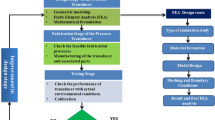Abstract
This paper describes the behavior of small foil strain gages under high pressure. Effects of pressure were determined and calibration curves were established in prelininary experiments. The calibrations were then used for correcting measured strains in pressure vessels.
Preliminary experiments at room temperature were conducted on small foil strain gages for pressures up to 35,000 psi. The effects of pressure on the gages bonded with a cynoacrylate contact cement, a room-temperature epoxy cement, a high-temperature epoxy cement and a filled epoxy resin were evaluated. Because the contact cement was least affected by pressure and was easiest to apply, it was chosen for use in successive experiments with different gage installations.
Calibration curves were determined for strain gages of 0.031-, 0.062- and 0.125-in. gage lengths. The compensating gages were under atmospheric pressure. The calibrations included the pressure effects of gages bonded on both concave and convex surfaces, and the effect of tensile prestrains. Data could be duplicated for successive pressure tests and for several gage installations. The calibration curves proved to be an effective way for obtaining accurate readings from the foil strain gages bonded internally to a pressure vessel.
Similar content being viewed by others
References
Clough, W. R., Shank, M. E., andZaid, M., “The Behavior of SR-4 Wire-Resistance Strain Gages on Certain Materials in the Presence of Hydrostatic Pressure,”SESA Proc., 10 (2),167–176 (1953).
Swanson, S. A. V., andFord, Hugh, “Stresses in Thick-Walled Plane Pipe Bends,”Jnl. Mech. Eng., Sci., 1 (2),103–112 (1959).
Eichberger, L. C., andSteele, M. C., “The Overstraining of Alloy-Steel Thick-Walled Cylinders,”T. & A. M. Report No. 101, University of Illinois, Urbana, Ill. 3, 4, 11, 12 and 15 (June 1956).
Steele, M. C., andEichenberger, L. C., “The Use of Foil Gages to Measure Large Strains Under High-Fluid Pressures,”SESA Proc., 13(1),151–160 (1955).
Guerard, J. P., andWeissman, G. F., “Effect of Hydrostatic Pressure on SR-4 Strain Gages,”Ibid., 16 (1),151–156 (1958).
Coffin, L. F., “The Flow and Fracture of a Brittle Materials,”Jnl. Appl. Mech., Trans. ASME, 17, (3),233 (September 1950).
Coffin, L. F., unpublished Sc.D. Thesis, Massachusetts Institute of Technology (1950).
Majors, H., Jr., “Influence of Fluid Pressure on SR-4 Strain Gages,”SESA Proc., 13 (1),13–24 (1955).
Author information
Authors and Affiliations
Rights and permissions
About this article
Cite this article
Gerdeen, J.C. Effects of pressure on small foil strain gages. Experimental Mechanics 3, 73–80 (1963). https://doi.org/10.1007/BF02326010
Issue Date:
DOI: https://doi.org/10.1007/BF02326010




